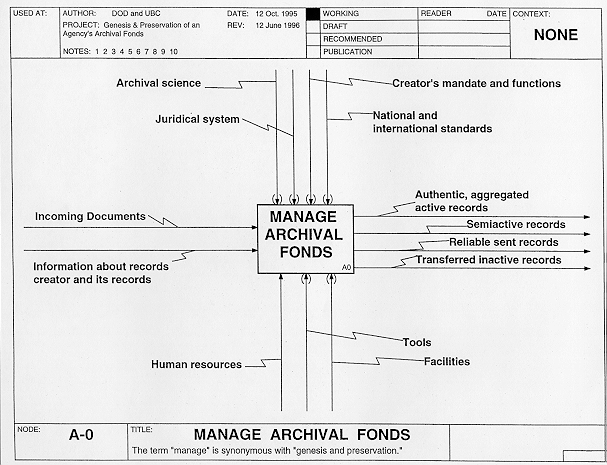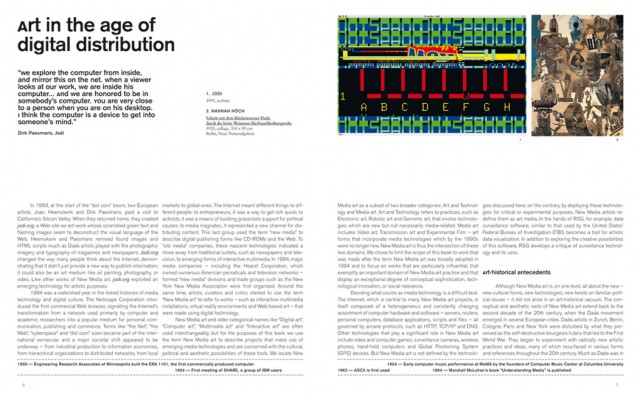http://three.org/ippolito/writing/wri_cross_museum.html""The Museum Is History" may sound like a harmless statement of fact to connoisseurs of bronzes and bibelots, but to connoisseurs of bits it's starting to sound like a rallying cry. In a world where 21st-century economies of reproduction and distribution are displacing 19th-century economics of acquisition and collection, storing one-of-a-kind treasures in a secure, climate-controlled vault would seem to serve little purpose for digital artists and curators. Why rely on a museum to confer respectability when you can earn it yourself on the World Wide Web? To this way of thinking, "The Museum of the Future" is little more than a contradiction in terms.
Like so many of digital art's seemingly radical aspects, its disdain for the museum is less an unprecedented innovation than an inherited trait. The genetic debt in this case is less to those siblings that usually get pride of place in digital art's family tree--namely avant-garde film, video installation, and kinetic sculpture--but rather with its more distant cousins from the 1960s and 1970s--Conceptual, Process, and Performance Art. Working with the Guggenheim Museum's Panza collection of work from that period, I've come to understand why certain strategies for "dematerializing" the art object failed--and how digital artists working three decades later can learn vital lessons from these mistakes. Most importantly, my research has led me to the ironic conclusion that the most extreme departures from the material object, digital or otherwise, are ultimately the ones whose future depends on the very institution they were designed to render obsolete.
Dan Flavin's fluorescent light installations are a case in point. Flavin deliberately chose only the eight or so standard colors of fluorescent tubing readily available. When the Guggenheim and Dia Center for the Arts mounted a retrospective of his work a few years ago, the curators discovered that one of those colors, the deep cherry red, had been discontinued because exposure to a toxic pigment coating the interior of the tube presented a workplace hazard to its manufacturers. As a consequence, the collectors of Flavin's work have had to buy up all the cherry red bulbs they could find to store them for use in future shows. What an irony that works based on the seemingly infinite reproduceability of industrial fabrication are now stored in the Guggenheim's warehouse like so many Kandinskys and Picassos!
Present-day aesthetes of digital art snicker at the naivete of artists from the 1960s like Flavin, but meanwhile they commit the same mistake in a decade where technical obsolescence occurs much faster than the thirty years it took Flavin's fluorescent tubes to go out of date. For example, the Web did not exist in its present form five years ago; what is the chance that it will exist five, ten, fifteen years from now? Regardless of what replaces the Web--3D projections, a VR interface, smart walls--there is no guarantee that the public will be able to view projects currently designed for the Web in that new medium.
To be sure, some artists making work for the Web argue that the sheer number of html pages out there encourages the likelihood that the information they contain will still be accessible in the future. True enough--but accessible in what form? Html is already a variable format, which is why the same Web page can look different on different people's screens. Individual users can set their browsers to various page sizes and background colors, default typefaces and sizes, even whether to display images at all--while still accessing the same ASCII data. To me, however, this variability of html makes it all the more likely that it will evolve into something else ten years from now. I don't see any reason that the millions of information-based Web pages now being produced from Boston to Bankok can't be ported to some future network protocol, much as we now translate old databases like dBASE into newer formats like Access. The process of conversion will not capture everything, but the average user will--and should--push for that conversion because it will offer her new features.
The problem, of course, is that the features that would likely be lost in such a conversion would be exactly those features on which Web artists currently depend. Most art projects now being made for the Web rely not just on a specific collection of verbal or quantitative information, but on a carefully controlled visual design or play on the medium that enframes them. What will become of an artist's precisely rendered 800- x 600-pixel bitmap if screen resolution jumps to 10,000,000 x 10,000,000? It will degenerate into either a tiny image in the middle of an otherwise blank screen, or a big image with appallingly low resolution.
This is not an academic question for museums that are considering acquiring Web projects into their collections. In the most publicized case to date of a museum collecting a Web site, the San Francisco Museum of Art "acquired" several sites into its design collection, including graphics from the influential art site ada'web. The trouble is, these images were merely stored on a CD-ROM for future viewing, thus reducing a dynamic, netcast original to a static image with no external links. This is a bit like owning a Ferrari on an island without any roads; it looks nice parked in your yard, but that's not the way it was meant to be experienced. (Storing Web pages on CD-ROMs doesn't exactly solve the problem of the eventual obsolescence of CD-ROMs, either.) Of course, artists or curators in the year 2020 will be able to run a Web project locally provided they unearth a fossilized Pentium and copy of Netscape, or hire a programmer to write an html emulator on a state-of-the-art desktop computer. But those are local solutions. If direct distribution over a global network wasn't important to an artist's work, then was their art really made for the Web in the first place?
Given the dizzying pace of technological advances, some argue that Web sites and other online projects are inherently ephemeral and cannot be collected. The problem with this policy, however, is that it encourages museums to fetishize the more conventional objects that the market has already approved, while letting the most radical work "slip through the cracks" of art history. That in itself might not make museums obsolete, but it would make them awfully boring.
How, then, can we avoid repeating the mistakes of Flavin's generation? By learning from the generation of artists who immediately followed. Minimalist artists like Flavin allowed their work to be destroyed and recreated over and over, as long as it was in the same medium. Certain artists from the subsequent movements we know as Conceptual, Process, or Performance Art, however, conceived of what I call *variable media*.
Exactly what aspect of the work was "variable" depended on the piece: it could be a relatively straightforward aspect like size and shape (in the case of Sol LeWitt's expandable wall drawings) or it could be the very content of the piece (as in Robert Barry's contribution to the PROSPECT '69 exhibition, which consisted of the ideas people had when reading his interview in the catalogue). Other aspects that could vary include configuration (Robert Morris's sculpture Permutation), composition (Barry Le Va's Ends Meet/Ends Cut installations), and even value (Douglas Huebler's Duration Pieces).
To be sure, LeWitt and Barry may have been thinking more about stretching the definition of art than about safeguarding their work for the future. But the strategies they invented offer digital artists and their collectors an alternative to packing away a cathode ray tube and Pentium PC in a climate-controlled crate. I've been discussing this alternative, which I call the Variable Media initiative, with my fellow curators at the Guggenheim. The idea is to:
1.
Recognize when a potential acquisition involves a variable medium. In some cases, such as the LeWitt and Barry pieces mentioned earlier, the variability of the medium is intrinsic to the artist's intent. In other cases, as in most fluorescent sculptures or Web pages, it is unintentional and stems from the fact that the conditions in which the piece was originally created will someday no longer be available.
2.
Contact the artist to determine if the piece has an "expiration date." Robert Rauschenberg, for example, considers his performances from the 1960s to be ephemeral works that cannot be recreated. Robert Morris, on the other hand, has restaged his performances from the same period in subsequent decades--with, of course, a different cast, props, etc.
3.
Interview the artist and any others involved in the original production of the piece to gather as much information as possible about the degree of flexibility inherent in the definition of the work. Can the work exist in two different locations at once? A Felix Gonzalez-Torres can; a Donald Judd can't. Can the work be freely distributed without permission? The answer is yes for copylefted software or Lawrence Weiner's piece in Collection Public Freehold, no for most other copyrighted material. Can the work be recreated at a variety of scales? Bill Viola specifies the projected image of his video installation _City of Man_ down to the centimeter. John Simon, meanwhile, considers his Java applet _Every Icon_ appropriate for a 15-inch monitor, a thirty-foot videowall, or even a handheld Palm Pilot.
4.
Acquire any documentation or objects, including scores, notes, props, photos, and moving images, that would be helpful to future recreators of the piece. The Whitney Museum owns a video of Barry Le Va making one of his felt scatter pieces, to help them recreate the installation if the artist is unavailable.
5.
Make this documentation available to anyone interested in restaging the work. The museum would then give its imprimatur to any performance or recreation of a work which it felt was consistent with the artist's original intent. Note that this vests the museum with an authority it never previously possessed: the capacity to declare a restaging authentic or not. However, it also burdens the museum with the responsibility to make information about the piece freely available--and perhaps to participate in the process of translating the work into a new medium and context if the old one is unrecoverable.
What is the incentive for us artists to hand over decisions about the future of our work to a prim bunch of curators who've never wielded a paintbrush or written a Java applet? Very simply, to ensure that other people will be able to see our work in some form once we are pushing up daisies. Many artists will not want to give up that measure of control and will choose to let their works die with them--and that's fine. Nevertheless, as outlandish as the idea may seem to traditional collecting practices, the
Variable Media initiative offers an alternative for those whose conception of their work goes beyond its manifestation in a particular form. And it helps us imagine the
museum as an incubator for living, changing artworks--rather than a mausoleum for dead ones."
++++
link to the directory of more of Jon Ippolito's writings:
http://three.org/ippolito/writing/
 Gebhard Sengmüller, Austria
Gebhard Sengmüller, Austria















 work done in the Library of Congress' Thesaurus of Graphic Materials, and MPEG-7 standardization efforts, we will study the theoretical and empirical aspects of the automatic detection of semantic concepts and their temporal and spatial relationships in video material informed by an indexing ontology."
work done in the Library of Congress' Thesaurus of Graphic Materials, and MPEG-7 standardization efforts, we will study the theoretical and empirical aspects of the automatic detection of semantic concepts and their temporal and spatial relationships in video material informed by an indexing ontology."



